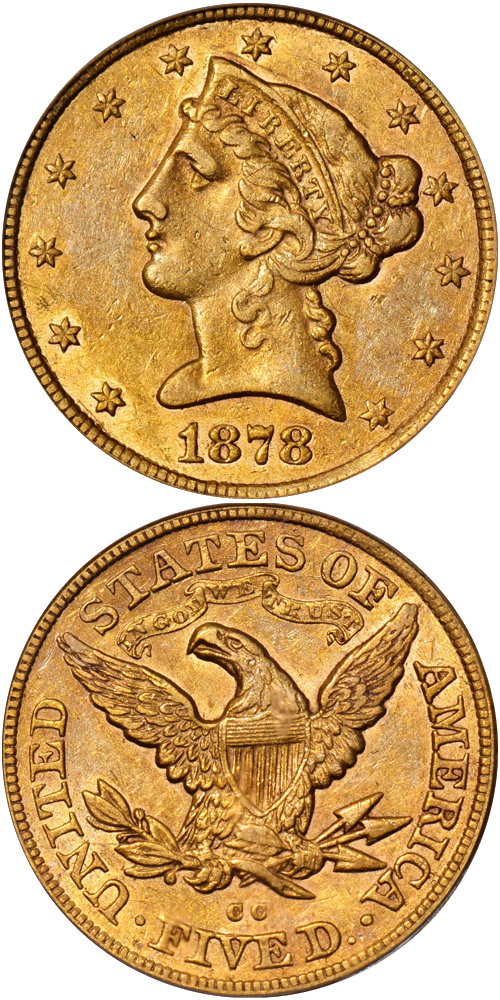1878-CC Liberty Head Half Eagle
Jeff Ambio: The only known die marriage of this issue exhibits a date that is placed low in the field and slants down to the viewer's right. The reverse has an even and compact CC mintmark with the edge of the arrow feather in line with the right side of the first C.
Rusty Goe: Director of the Mint H.R. Linderman in his 1878 annual report shed light on why the mints had turned out substantially lower quantities of half eagles and eagles between 1862 and 1877 (with the exception of 1873 for half eagles and 1874 for eagles only at Philadelphia). "Our gold coinage," he said, "since the suspension of specie payments in 1861 has consisted principally of double eagles..." Simply put, citizens, especially east of the Rocky Mountains, had grown accustomed to using paper money for payment in most everyday transactions, whereas, prior to 1861, specie (coin money) up to $10 in value had circulated as the main currency. Residents in the western states and territories never embraced paper money.
Double eagles, introduced in 1850 and the largest coin denomination issued by the government, were at times used in everyday transactions, especially out West, but were generally used for interbank exchanges, Treasury reserves, and international trade. As the Treasury Department prepared in 1878 for a resumption of specie payments scheduled to begin in January 1879, it called on its two most productive mints, at Philadelphia and San Francisco, to increase their outputs of $5 and $10 gold pieces. The Carson City Mint would not play a role in this plan, but would concentrate on the production of the new standard silver dollars, and only produce enough gold coins to satisfy the demands of depositors and local commerce.
The face value output of gold coins in Carson City in 1878 slumped to its lowest level since 1870, the mint's first year in business. By the end of April 1878, so absorbed were mint workers in the production of the new silver dollars, gold coinage was virtually put on hold. At some point before mid-June the coining department struck 3,784 half eagles dated 1878. It added another 5,270 pieces in the second half of the year for a total yield of 9,054 pieces.
Q. David Bowers: Rusty Goe estimates 90 to 120 1878-CC half eagles survive, with two Uncirculated. In my studies I found one Mint State and estimated 50 to 70 in circulated grades. Again, here is a first-class rarity. When Doug Winter studied CC gold coins in the 1990s he was not able to find even one Mint State, but by 2001 an MS-63 had been certified by NGC. VF is the usually seen grade, but EF pieces, while very rare, come on the market often enough that the patient specialist can acquire one.
The 1878-CC is a prime rarity among Carson City half eagles and is near the top of the list, close on the tail of the even rarer 1870-CC and 1873-CC. Douglas Winter reports examining a numismatic hoard of 13 coins, Good to EF, that had been accumulated by a West Texas collector by December 1991; the group had taken 15 to 20 years to assemble. Perhaps the sequestering of these pieces prompted some to say that the 1878-CC was the second rarest of all Carson City half eagles, a status from which it has since slipped. Or has it?
The example to the left was sold by Stack's Bowers Galleries in the Spring 2022 Showcase Auction, where it realized $34,800.






